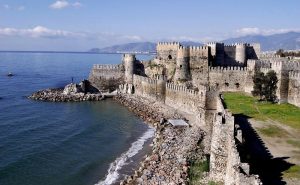Kleopatra, Alanya
The town (115 km/72 miles east of Antalya) is busy and crowded, but the beaches are so long (22 km/14 miles to the east) that there’s plenty of sand for everyone. Great Seljuk castle, too
With its historic peninsula, Alanya has traces of many ancient civilizations. The summer capital of the Anatolian Seljuk State, Alanya contributes to the region’s tourism thanks to the beach, which bears the name of the last Hellenistic queen of ancient Egypt, Cleopatra, who lived between 69-30 B.C. She is said to have sunbathed on the beach’s golden sands and to have swum in its crystal blue waters.
The beach in the city center is one of the most popular spots for tourists due to its golden sand, clean water, and attractive coast. The two-kilometer beach is a fine combination of “sea, sand, and sun.”
The beach has hosted millions of local and foreign tourists so far said Servet Şakiroğlu, the head of the Cleopatra Hoteliers Association, which hotels around the beach are members of.
Speaking to Anadolu Agency, Şakiroğlu said Cleopatra swam around the Kale peninsula.
“It is rumored that between 69 B.C. to 30 B.C., the Roman [Marcus] Antonios gifted the queen the Sedre village for the formation of the Egyptian fleet. The beach has gained importance because the queen swam here and fell in love with its sands,” he said.
Şakiroğlu said the beach has also drawn interest for its rice-sized grains of sand and crystal blue waters.
“It is one of the rare places in the world where people can swim in the city center. We also have Damlataş Inns in this region. Various activities are organized on the beach. The first beach organizations began to be organized here in the district,” he said.
The association head said Alanya welcomes 3.5 million tourists a year and 80 percent of those tourists swim at Cleopatra beach.




